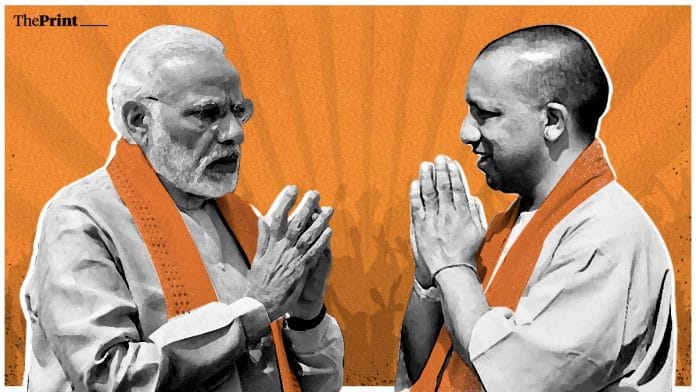The 2024 Lok Sabha election results were a far cry from last week’s exit polls. The BJP failed to cross the majority mark on its own – its momentum spectacularly halted by INDIA-bloc member Samajwadi Party in Uttar Pradesh. This outcome should be interpreted more as a mandate against the Yogi Adityanath government in UP rather than the Narendra Modi government at the Centre.
The constituency-wise map of seats won by the BJP, SP, Congress, Rashtriya Lok Dal (RLD), Apna Dal, and Aazad Samaj Party (Kanshi Ram), reveals significant patterns. The Opposition’s winning streak began from Saharanpur, merging with another from Kheri in the upper Bundelkhand region, reaching Allahabad and continuing through the SP-dominated Etawah-Mainpuri region. A second wave of Opposition victory swept Awadh and Eastern UP.
The BJP won mostly in Western UP – particularly in areas with a significant Jat population – and in central UP, which includes Rohilkhand and the Terai region near Gorakhpur. The BJP and its ally, Apna Dal, won in Lucknow and three seats near Varanasi (Phulpur, Bhadohi, and Mirzapur). Jhansi and Shrawasti were exceptions; the BJP won the former while the SP won the latter.

Mandate against Modi or Yogi?
The win and loss patterns suggest either undercurrents or meticulously designed social engineering in these regions. If these factors weren’t at play, the BJP and SP’s winning seats would have been randomly distributed across the state. It appears that RLD chief Jayant Chaudhary brought significant relief for the BJP in Western UP, while Yogi Adityanath prevented the party’s defeat in the Terai regions of Gorakhpur.
But what sustained the BJP in parts of Rohilkhand and central UP needs further exploration. One tentative explanation is the removal of Bahujan Samaj Party’s Akash Anand from the campaign, which could have shifted a section of Dalit voters from the BSP to the SP and Congress. The other could be the domination of Lodh voters – who have traditionally supported the BJP – in central UP.
Also read: Indian voters have defeated the hubris of populism
No intent to solve problems?
The decimation of the BJP in UP shows that the mandate is against Yogi, not Modi. If there was indeed an undercurrent against the prime minister, the BJP would not have swept Himachal Pradesh, Uttarakhand, New Delhi, Madhya Pradesh, Chhattisgarh, and Bihar. The boundaries of these states touch UP, but there’s no noticeable impact. Several key factors have contributed to this.
First, the unemployment rate in the state remains high, and the government’s efforts to address this issue have been insufficient. Frequent leaks of examination papers for government jobs have further eroded public trust. These leaks have resulted in delays and cancellations of recruitment exams, frustrating job seekers and their families.
Second, reservation policies have been poorly implemented, leading to widespread dissatisfaction among various communities. The mishandling of these policies has created a perception of injustice, which Opposition parties have managed to successfully capitalise on.
Third, stray cattle have become a major problem in rural areas. The government’s cattle protection policies have led to an increase in stray cattle, causing damage to crops and posing a threat to villagers. This has been a critical issue for farmers, who form a big chunk of the electorate.
Fourth, there’s an increasing perception of corruption at the grassroots level, which I was alerted about during my recent field visit to the state. Accusations of corruption and malpractice against local government officials and bureaucrats could have had an alienating effect on voters. The inability to curb this corruption could be seen as a failure of the Yogi Adityanath administration.
Fifth, statements from BJP leaders about changing the Constitution further instilled fear and facilitated the shift of Dalit voters to the SP-Congress camp. And last, instead of resolving any of these problems, the BJP seemed to rely heavily on its welfare schemes.
While the party performed well in other states, its poor showing in UP highlights its failure to solve crucial problems. Unemployment, poor implementation of reservation policies, the cattle menace, and grassroots-level corruption have all contributed to voter dissatisfaction. The Opposition’s success in uniting against the BJP and addressing them effectively has contributed immensely to their impressive winning streak.
Arvind Kumar (@arvind_kumar__) is Assistant Professor at the Department of Law and Criminology, Royal Holloway, University of London. Sanjay Kumar, CSSP National Coordinator & Professor, Y.D. College, Lakhimpur-Kheri. Views are personal.
(Edited by Zoya Bhatti)







The article looks like the exit polls that was unleashed on 1st. Biased and with an agenda. Not sure if the author has any BJP affliation or is traditional supporter of Mr Modi. This looks like an attempt to pass the blame to Mr Adityanath. The election was fought by Mr Modi on his name and performance. My only question to the author if Modi won 240 seats, why should he not be responsible for the ones that were lost